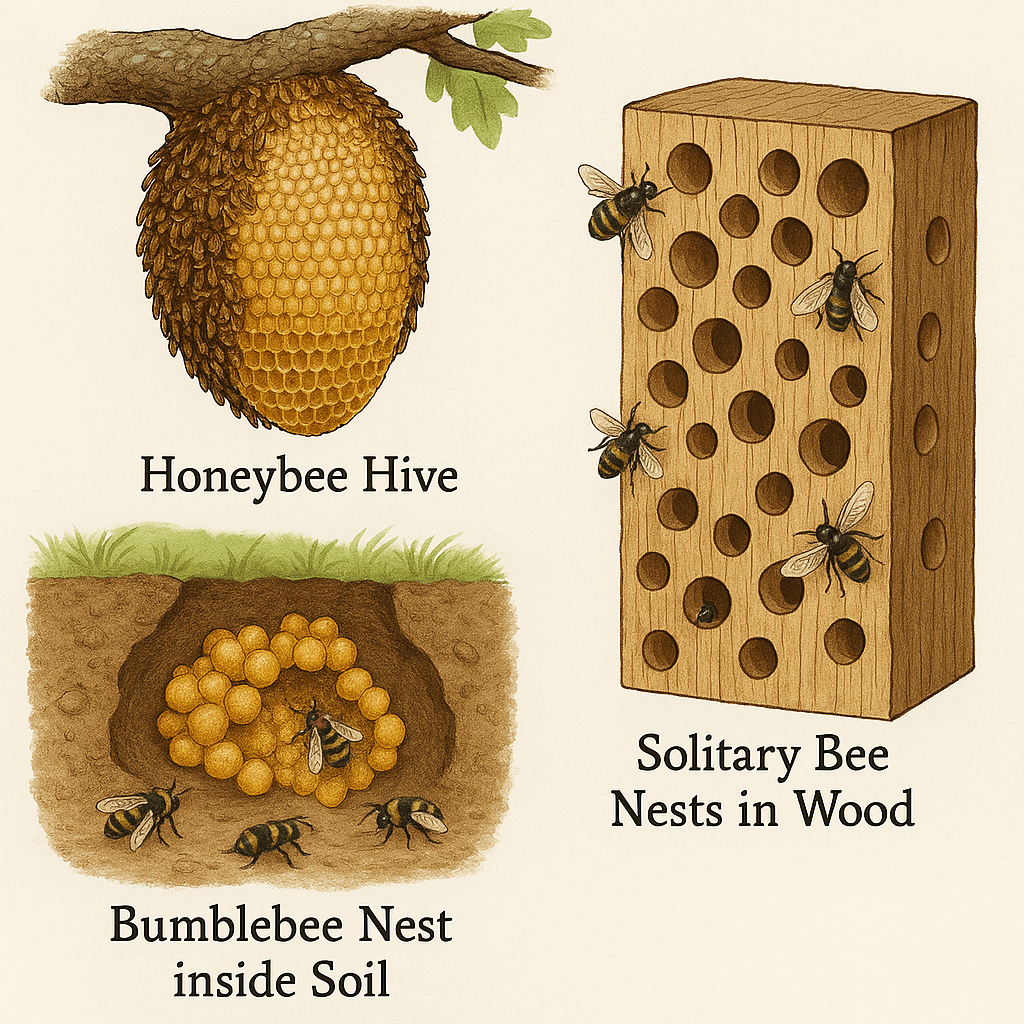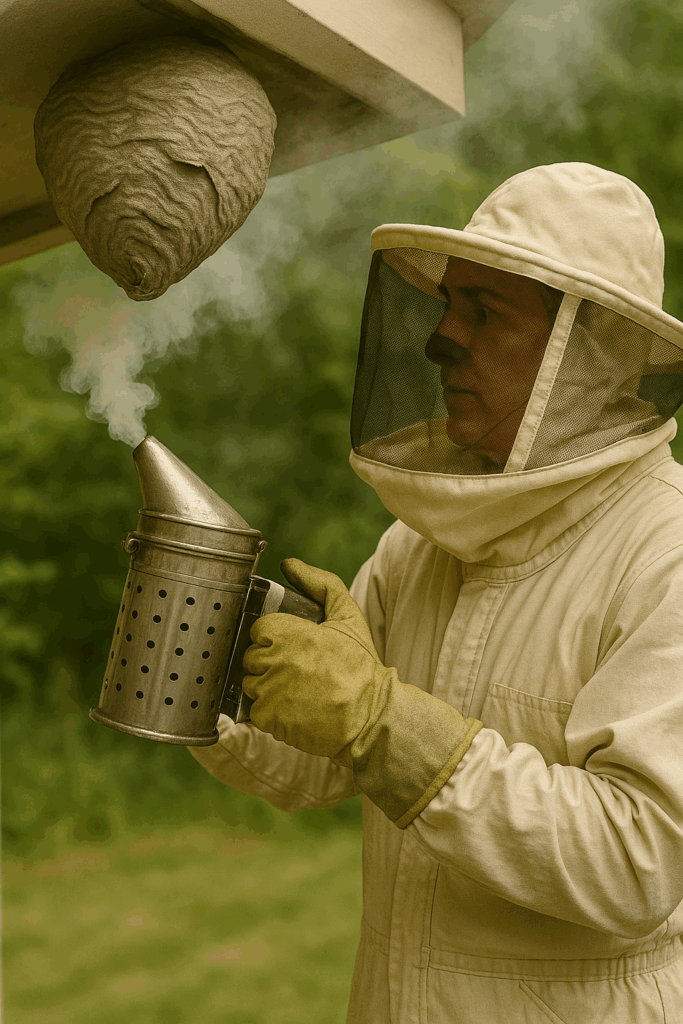
1. Introduction to Bee and Wasp Nests
Let’s be real: stumbling upon a buzzing nest while trimming your hedge is not fun. But wait—was that a bee? Or a wasp? Panic aside, telling them apart could save you from a sting (or ten). This guide will help you identify, differentiate, and safely deal with bee and wasp nests around your home.
Difference Between Bees and Wasps

Bees are the fluffy vegetarians of the insect world, while wasps are the sleek carnivores. Bees pollinate flowers and mostly mind their business. Wasps? They’re aggressive, especially if you wave at them. Not ideal picnic guests.
Why Nest Identification Matters
- Bee nests are usually safe to leave alone.
- Wasp nests, especially yellow jackets, can be dangerous.
Proper identification helps you:
- Avoid stings
- Choose the right pest control approach
- Protect local pollinators (like honey bees!)
Common Misconceptions
- Not all nests in trees are bee hives.
- Not all aggressive insects are wasps.
- Mud nests don’t always mean wasps.
Overview of What We’ll Cover
This post will break down:
- How bee and wasp nests differ
- Where to find them
- What to do when you spot one
- How to keep them away
Let’s dive in!
2. Understanding Bee Nests
Bee nests are like nature’s condos—organized, structured, and quite clean.
Appearance and Structure
Bee nests are:
- Waxy and soft-looking
- Made from chewed wax
- Filled with hexagon-shaped honeycombs
- Often hidden inside cavities
Bee nests are typically pale yellow to brown in color. They have a smooth and waxy texture, and their shape is usually rounded or made up of layered panels.
Where Bees Commonly Build Nests
- Hollow tree trunks
- Wall cavities
- Attics or sheds
- Abandoned birdhouses
Behavior of Nesting Bees
Bees:
- Swarm quietly
- Defend if provoked
- Rarely attack unless near the hive
Tip: If you hear a low hum and see steady traffic of bees going in and out of one spot—they’re probably nesting.
Common Types of Nesting Bees
- Honey Bees – build inside trees or walls
- Bumble Bees – prefer ground burrows or insulation
- Carpenter Bees – dig tunnels in wood (they don’t build nests per se)
3. Understanding Wasp Nests
Now let’s talk about the troublemakers: wasps.
🪵 Visual Traits of Wasp Nests
Wasp nests are:
- Papery and greyish
- Made from chewed wood pulp
- Usually have a honeycomb structure inside
- Often shaped like inverted teardrops
The color of a wasp nest is usually grey or tan. Its texture feels paper-like and fragile. The shape can be round, oval, or even teardrop-shaped.
Places Where Wasps Nest
- Under eaves
- Deck overhangs
- Bushes or trees
- Wall cavities
- Inside grills or equipment
Behavior of Nesting Wasps
Wasps:
- Patrol near their nests
- Sting multiple times
- Are highly territorial
Warning signs include aggressive buzzing and sharp dive-bombing behavior when you approach.
Common Wasp Species
- Yellowjackets – super aggressive, nest underground or in walls
- Paper Wasps – calmer, build open comb nests under eaves
- Mud Daubers – harmless loners who build mud tubes
4. Key Differences Between Bee and Wasp Nests
So how can you tell them apart with one look? Let’s break it down.
Nest Materials and Construction
- Bees: Wax
- Wasps: Chewed wood = paper
Nest Shapes and Textures
- Bee nests: Hidden, soft, comb-based
- Wasp nests: Visible, papery, rounded
Aggression Level of the Species
- Bees: Chill unless provoked
- Wasps: Aggro by default
Seasonal Patterns
- Bees: Year-round in warm areas
- Wasps: Peak in summer, die in winter (except queens)
Bee nests tend to have consistent, steady activity. In contrast, wasp nests become much more active during the warmer months.
5. Where to Look for Bee or Wasp Nests
These pests are masters of hiding. But once you know where to look…
🪵 Outdoor Common Nest Sites
- Trees and shrubs
- Beneath decks
- Roof eaves
- Sheds and garages
Indoor Nest Hiding Spots
- Behind walls
- In chimneys
- Attics
- Inside furniture or vents
Environmental Factors
- Warmth
- Access to food
- Water nearby
- Shelter from wind and rain
Nesting Signs and Early Clues
- Constant insect traffic to one spot
- Buzzing near windows or walls
- Small holes or chew marks (carpenter bees!)
- Papery structures on surfaces
6. What to Do When You Find a Bee and Wasp Nests

Okay, you’ve found it. Now what?
Safety First
- Don’t get close.
- Keep pets and kids away.
- Stay calm—no swatting!
What Not To Do
- Don’t spray water
- Don’t throw things
- Don’t poke the nest (please)
When to Call a Professional
- If it’s a large nest
- If wasps are aggressive
- If it’s inside your walls
Temporary Home Remedies
You can spray peppermint oil as a natural deterrent. Placing fake wasp nests can also help keep real wasps away. Try using clove or citronella candles nearby, and make sure to seal any entry points to prevent them from getting inside.
But again—don’t try this if you’re allergic or unsure.
7. Prevention Tips and Final Thoughts
Now that you know the risks, let’s avoid them altogether.
How to Deter Nesting in the Future
- Seal cracks and entry points
- Keep trash bins tightly shut
- Trim trees and shrubs near the house
Safe Maintenance Tips
- Check eaves and overhangs monthly
- Avoid leaving food outdoors
- Clean up spills and sugary drinks fast
Natural Repellents
- Peppermint oil
- Clove oil
- Lemon + vinegar mix
- DIY wasp deterrent spray
Final Recap
- Bee nests = good pollinators, avoid disturbing
- Wasp nests = potential hazard, handle with care
- Learn the signs, act safely
FAQs
1. What’s the easiest way to tell a bee nest from a wasp nest?
Wasp nests are papery and visible. Bee nests are waxy and often hidden.
2. Are wasps more dangerous than bees?
Yes. Wasps can sting multiple times and are more aggressive.
3. Can I remove a small wasp nest myself?
If it’s early and small, maybe. But it’s safest to call a pro.
4. Will bees attack if I go near their nest?
Usually not. But don’t push your luck. Stay calm and back away.
5. What should I do if I find a nest indoors?
Leave it alone and call pest control. Do not attempt to handle it.
